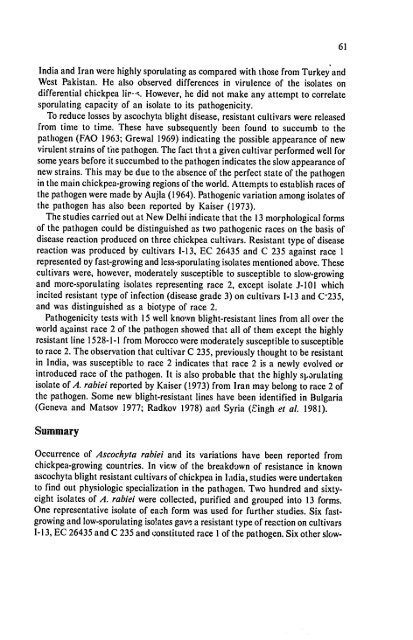I - --ii
I - --ii
I - --ii
You also want an ePaper? Increase the reach of your titles
YUMPU automatically turns print PDFs into web optimized ePapers that Google loves.
India and Iran were highly sporulating as compared with those from Turkey and<br />
West Pakistan. He also observed differences in virulence of the isolates on<br />
differential chickpea lir-... However, he did not make any attempt to correlate<br />
sporulating capacity of an isolate to its pathogenicity.<br />
To reduce losses by ascochyta blight disease, resistant cultivars were released<br />
from time to time. These have subsequently been found to succumb to the<br />
pathogen (FAO 1963; Grewal 1969) indicating the possible appearance of new<br />
virulent strains of the pathogen. The fact that a given cultivar performed well for<br />
some years before it succumbed to the pathogen indicates the slow appearance of<br />
new strains. This may be due to the absence of the perfect state of the pathogen<br />
in the main chickpea-growing regions of the world. Attempts to establish races of<br />
the pathogen were made by Aujla (1964). Pathogenic variation among isolates of<br />
the pathogen has also been reported by Kaiser (1973).<br />
The studies carried out at New Delhi indicate that the 13 morphological forms<br />
of the pathogen could be distinguished as two pathogenic races on the basis of<br />
disease reaction produced on three chickpea cultivars. Resistant type of disease<br />
reaction was produced by cultivars 1-13, EC 26435 and C 235 against race I<br />
represented oy fast-growing and less-sporulating isolates mentioned above. These<br />
cultivars were, however, moderately susceptible to susceptible to slow-growing<br />
and more-sporulating isolates representing race 2, except isolate J-101 which<br />
incited resistant type of infection (disease grade 3) on cultivars 1-13 and C'235,<br />
and was distinguished as a biotype of race 2.<br />
Pathogenicity tests with 15 well known blight-resistant lines from all over the<br />
world against race 2 of the pathogen showed that all of them except the highly<br />
resistant line 1528-1-1 from Morocco were moderately susceptible to susceptible<br />
to race 2. The observation that cultivar C 235, previously thought to be resistant<br />
in India, was susceptible to race 2 indicates that race 2 is a newly evolved or<br />
introduced race of the pathogen. It is also probable that the highly slorulating<br />
isolate of A. rabiei reported by Kaiser (1973) from Iran may belong to race 2 of<br />
the pathogen. Some new blight-resistant lines have been identified in Bulgaria<br />
(Geneva and Matsov 1977; Radkov 1978) and Syria (Eingh et al. 1981).<br />
Summary<br />
Occurrence of Ascochyta rabiei and its variations have been reported from<br />
chickpea-growing countries. In view of the breakdown of resistance in known<br />
ascochyta blight resistant cultivars of chickpea in Ildia, studies were undertaken<br />
to find out physiologic specialization in the pathogen. Two hundred and sixtyeight<br />
isolates of A. rabiei were collected, purified and grouped into 13 forms.<br />
One representative isolate of each form was used for further studies. Six fastgrowing<br />
and low-sporulating isolates gave a resistant type of reaction on cultivars<br />
1-13, EC 26435 and C 235 and ':onstituted race I of the pathogen. Six other slow<br />
61

















